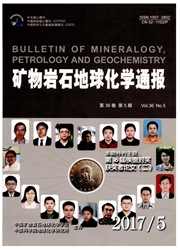

 中文摘要:
中文摘要:
西天山博罗科努地区普遍发育古生代地层,为系统研究该地区古生代的构造演化史,本文对区内寒武系 下二叠统地层进行了系统的地球化学分析.结果表明,区内古生代地层的SiO2含量为66%~73%,各组地层的TFeO+MgO、Al2O3/SiO2和Rb、Ba、Sr、Th/U、La/Sc、La/Th值,以及稀土元素组成等地球化学参数均与上地壳平均组分相当.寒武系为泥岩、泥灰岩,中奥陶统科克萨雷溪组为泥岩,其他组地层的砂岩大多为杂砂岩,其次为岩屑砂岩和长石砂岩.除寒武系、中奥陶统和下二叠统含有沉积再旋回物质外,其他各组地层源区均经历了较弱的化学风化作用,其物源主要为长英质火成岩.构造环境判别表明,博罗科努地区在寒武纪—早奥陶世期间为被动大陆边缘环境,中奥陶世转为活动大陆边缘,发生俯冲作用;中泥盆世进入俯冲间歇期,晚泥盆世开始了新一轮更强烈的俯冲作用;晚石炭世开始碰撞造山,形成统一的大陆;早二叠世进入稳定的板内发展阶段.
 英文摘要:
英文摘要:
Paleozoic strata are widespread throughout the Boluokenu area,West Tianshan.We here present the results of geochemistry of the Cambrian to the Lower Permian Formation strata in this area.The contents of SiO2 are in the range of 66%-73% for the majority of the Boluokunu Paleozoic strata.Each formation has similar geochemical parameters,such as TFeO+MgO,Al2O3/SiO2,Rb,Ba,Sr,Th/U,La/Sc,La/Th and REEs compositions,which are similar to those average values of the upper continental crust.The Cambrian strata are composed of mudstones and marl rocks,while the Middle Ordovician Kekesaleixi Formation is made up of mudstones.Geochemical classification of other formations show that the strata are dominated by greywackes intercalated with litharenite and arkose.Provenance analysis indicate that the Middle Ordovician and the Lower Permian samples contain a certain proportion of sedimentary recycling composition,while the source area of other strata experienced weak chemical weathering.The provenances mainly were felsic igneous rocks.Tectonic discrimination allow us to develop the following model for plate tectonics in the Boluokenu area.During the Cambrian to the Early Ordovician,the Boluokenu area was in a passive continental margin tectonic environment,then the tectonic environment changed to an active continental margin in the middle Ordovician.The subduction process intermitted during the Middle Devonian,a stronger round of subduction started in the Late Devonian.During the Late Carboniferous,the Yili plate collided with the Zhungaer plate and formed an unified continent.In the Early Permian,the region entered into the intracontinental evolution stage.
 同期刊论文项目
同期刊论文项目
 同项目期刊论文
同项目期刊论文
 期刊信息
期刊信息
